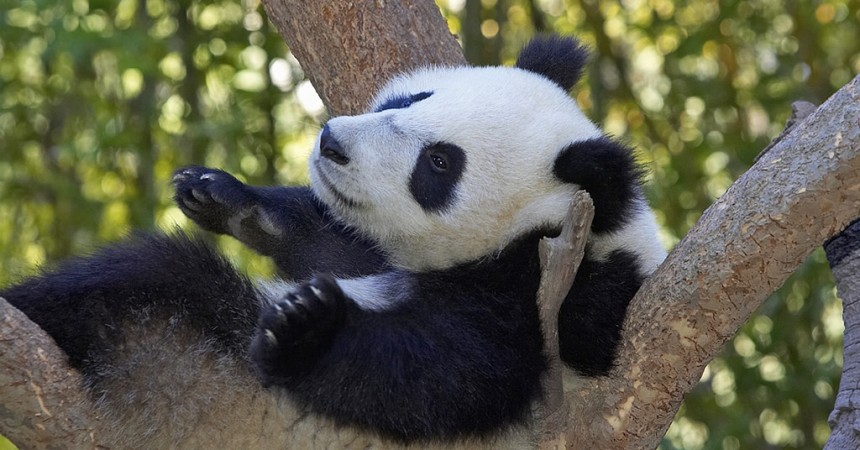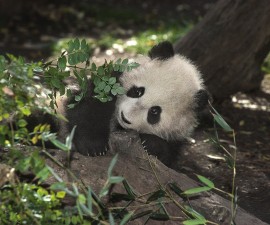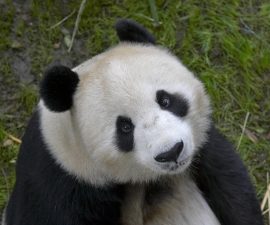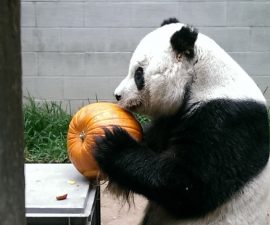It seems like only yesterday that I first started working with giant pandas. In February 1997, having spent the previous four years focused on fieldwork in the Arctic, I was hired on to the San Diego Zoo’s ‘Panda Team’. As the Panda Conservation Program was taking shape, I remember well spending hours collecting behavioral data on Bai Yun and Shi Shi, getting to know the rest of the scientists and animal care staff on the Panda Team, and being introduced to our visiting colleagues from the Wolong breeding center in China. Now, 18 years later, I have the pleasure of seeing both our bears, and our program “grow up”, and of seeing Chinese colleagues–most of whom I first met in the 1990’s–still actively engaged in efforts towards the conservation of giant pandas.
Earlier this month I traveled to China, along with Ron Swaisgood (co-head of our giant panda program), to meet with a range of scientists and wildlife managers and discuss the current status and future directions of panda conservation research program. It was a fantastic trip—productive, uplifting and emotional. It was a trip filled with familiar faces and ample opportunities to visit with long-time colleagues and old friends (both human and panda).
The first leg of our trip was focused on meetings in Beijing, with our colleagues at the Chinese Academy of Science. We discussed giant panda research efforts in the Foping Nature Reserve over the course of the three days we were there, but of course, there was also the wedding we were invited to: A student we hosted for a year at the San Diego Zoo was thrilled to have his ‘San Diego Family’ attend this important family event.
After a few days, we left Beijing, and headed south to Sichuan Provence, where we were to visit the four panda bases: Bi Feng Xia, Dujianyan, Genda, and Heataoping (aka Wolong). After our long-time collaborator, Mr. Zhou, met us at the hotel in Chengdu, we loaded up and started the drive to Bi Feng Xia base. Five minutes into our drive, we were comparing digital photographs on our phones of our children: amazing to see how they’ve grown! Beautiful smiles of teenagers and young-adults, quickly compared to the beautiful smiles of their toddling counterparts. This ritual was repeated over and over and over again throughout our time in Sichuan, with each colleague we saw, and with seemingly mounting levels of enthusiasm. It felt like a family reunion.
Of course the centerpiece of our family reunion was the pandas, and getting status updates and seeing the San Diego Zoo born pandas was a primary objective for me. With visits to all four facilities under our belts, I am very happy to say that I was able to check in with all of ‘our’ bears, and that all are doing well! Below, I provide updates on each, and pictures of all but Zhen Zhen and Mei Sheng. Because Hua Mei and her cub were in the reintroduction training pens, I had to take the photos at a distance, so they are a bit blurry.
Hua Mei b. 1999
Hua Mei has followed Bai Yun’s footsteps in that she has been an incredibly productive mother panda! In 2013, she gave birth to her 11th cub, a male named Hua Long. Currently, beautiful Hua Mei and Hua Long reside at the Wolong Research Base in Hetaoping. This locale–the original panda research base,—was hit hard by the earthquakes of 2008. Amazingly though, most of the animal holding areas are in great shape, and Hua Mei and her cub are living in the first phase reintroduction training area. This means that Hua Long may one day be released to the wild: A very exciting prospect for one of our very own “grandchildren”.
Mei Sheng b. 2003
Mei Sheng is living at the Bi Feng Xia base near Ya’an. Mei Sheng is part of the breeding program, however, he doesn’t seem to have yet taken after his father’s studly ways. Mei Sheng is now almost 12 years old, but successful breeding has been elusive. Regardless, he is a happy and healthy panda with much space to explore and enjoy his time.
Su Lin b. 2005
Su Lin gave birth to her second surviving cub in 2014. Currently, Su Lin and her beautiful young cub are living at the panda research base at Hetaoping. Her enclosure lies about 100 feet from where her sister Hua Mei is living. I wonder if they know how truly close they are? Both Su Lin and her cub look great, and appear to be thriving.
Zhen Zhen b. 2007
Zhen Zhen resides at Bi Feng Xia, is part of the breeding program, and is doing well. She has given birth twice—one stillborn, and another cub that did not survive. While this is not typical, this does not preclude Zhen Zhen from successfully giving birth and rearing cubs in the future. We are all pulling for her and hope that she will be successful in 2015 if she gets pregnant.
Yun Zi b. 2009
Yun Zi was always one of my favorites. At 5.5 years old, Yun Zi is too young for the breeding program. He is living at the research base at Dujianyan and has access to a large outdoor enclosure. These new facilities are beautiful and he is thriving there! A plaque by his enclosure filled me with pride, and reminded me of the mutual respect with which we hold our colleagues: “Yun Zi. Birthplace: San Diego Zoo in America. He is the achievement of scientific and research cooperation between China and America.”
There is still so much for us to learn about giant pandas, and we know that there are many challenges still ahead for us in our efforts to conserve this iconic species. However, the good news is that we are moving forward together, as an extended and international family, with the same goal: conserving giant pandas and giant panda habitat, well into the future.
Megan Owen is an associate director in the Applied Animal Ecology Division, San Diego Zoo Institute for Conservation Research. Read her previous post, What’s Up with Bai Yun?









